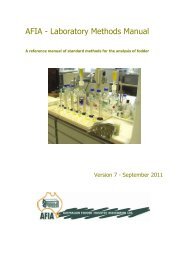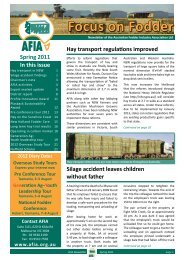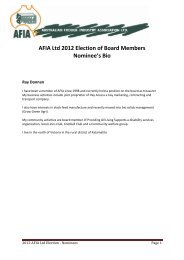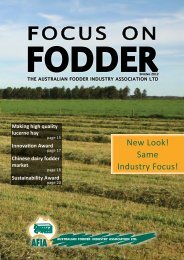Focus on Fodder - Australian Fodder Industry Association
Focus on Fodder - Australian Fodder Industry Association
Focus on Fodder - Australian Fodder Industry Association
Create successful ePaper yourself
Turn your PDF publications into a flip-book with our unique Google optimized e-Paper software.
...district reports<br />
C<strong>on</strong>tinued from page 1<br />
Queensland<br />
There is a significant gap between the market for Lucerne to<br />
horse and cattle markets. The supply of premium quality hay<br />
for the horse market is diminishing rapidly, while the supply<br />
of lower grades for the dairy and feedlot sector are adequate<br />
due to hay being bleached during the producti<strong>on</strong> seas<strong>on</strong>.<br />
Equine markets are paying anywhere from $60–120/mt<br />
premium for hay that meets their specs. The challenging<br />
trading envir<strong>on</strong>ment for feedlots is dampening their demand<br />
for hay and straw for their rati<strong>on</strong> mixes. This seas<strong>on</strong>s winter<br />
hay crop is in good shape with cereals <strong>on</strong> track for solid yields.<br />
Price ($/t)<br />
400<br />
350<br />
300<br />
250<br />
200<br />
150<br />
Cereal hay and grain prices, south east Qld<br />
Cereal hay 2011<br />
Cereal hay 2012<br />
Wheat 2011<br />
Wheat 2012<br />
100<br />
Jan Feb Mar Apr May Jun Jul Aug Sep Oct Nov Dec<br />
New South Wales<br />
The central west of NSW is experiencing a great seas<strong>on</strong><br />
and demand for hay is high from riverina dairies and cattle<br />
producers. Chaff markets are also active hay prices have<br />
c<strong>on</strong>sistently been rising over the last few m<strong>on</strong>ths. The Bega<br />
Valley remains quiet as a destinati<strong>on</strong> for hay. Most farms in<br />
the valley are now relatively self sufficient, though there are<br />
odd lots of cereal moving from the central west for those<br />
looking for some fibre in their cows diet.<br />
Victoria<br />
As vehicle registrati<strong>on</strong> plates suggest, Victoria is “the place to<br />
be” for hay producers. The demand from western Victorian<br />
cattle producers and south west dairies has been str<strong>on</strong>g over<br />
the last four m<strong>on</strong>ths and is expected to c<strong>on</strong>tinue through to<br />
August until pastures achieve some growth. The dry spring<br />
and late autumn break has been the catalyst for this higher<br />
than usual demand. In c<strong>on</strong>trast Gippsland has had high<br />
fodder demand due to the wet autumn and winter period.<br />
South Australia<br />
Similar to Victoria there is a high level of demand for fodder<br />
from south east dairies for both Lucerne and cereal hay. Due<br />
to the high level of export demand, cereal hay is difficult to<br />
source and most are using local pasture hay as an alternative.<br />
Acreages sown to oaten hay are at a more “normal” level<br />
this year which is up <strong>on</strong> 2011 sowings and fuelled by a<br />
page 10 AFIA Newsletter Winter 2012<br />
Price ($/t)<br />
The Markets<br />
str<strong>on</strong>g export market. Export hay processors are positive<br />
about increasing volumes to China and the Middle East and<br />
are backing their judgement by increasing their processing<br />
capacity.<br />
Western Australia<br />
There has been some slight movement in the market for hay<br />
into south west dairies but mainly for local pasture hay, there<br />
has not been the need to source cereal hay further afield<br />
from cropping z<strong>on</strong>es. High quality hay is extremely hard to<br />
find and horse markets are paying a premium for hay without<br />
weather damage. Chaff processors are struggling to find<br />
premium quality lucerne to meet demand. As a c<strong>on</strong>sequence<br />
of the tough curing c<strong>on</strong>diti<strong>on</strong>s last year and the difficulty in<br />
selling weather damaged hay, acreages sown to oaten hay<br />
varieties appear to be down around 20%.<br />
Price ($/t)<br />
400<br />
350<br />
300<br />
250<br />
200<br />
150<br />
100<br />
Jan Feb Mar Apr May Jun Jul Aug Sep Oct Nov Dec<br />
400<br />
350<br />
300<br />
250<br />
200<br />
150<br />
Cereal hay and grain prices, south west WA<br />
Cereal hay 2011<br />
Cereal hay 2012<br />
Wheat 2011<br />
Wheat 2012<br />
Cereal hay 2011<br />
Cereal hay 2012<br />
Wheat 2011<br />
Wheat 2012<br />
100<br />
Jan Feb Mar Apr May Jun Jul Aug Sep Oct Nov Dec<br />
Tasmania<br />
The host state of the AFIA Nati<strong>on</strong>al <strong>Fodder</strong> C<strong>on</strong>ference is<br />
experiencing a fantastic seas<strong>on</strong> and demand for purchased<br />
hay is low. However due to wet c<strong>on</strong>diti<strong>on</strong>s fodder<br />
c<strong>on</strong>sumpti<strong>on</strong> by dairy cows is quite high but the demand is<br />
being met by hay produced <strong>on</strong> farm. It is anticipated that this<br />
situati<strong>on</strong> will remain the same for the rest of the winter. A







